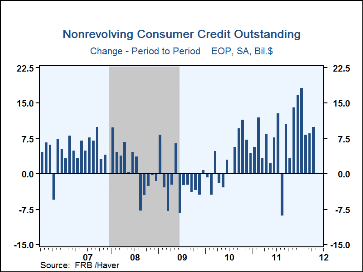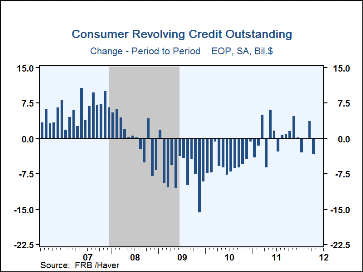 Global| Jun 07 2012
Global| Jun 07 2012U.S. Consumer Credit Growth Eases
by:Tom Moeller
|in:Economy in Brief
Summary
Growth in consumer credit outstanding is positive, just not like estimated earlier. It increased $6.5B (AR) in April following a $12.4B March gain, initially reported as $21.3B. During the prior four months, increases averaged $15.0B [...]
 Growth in consumer credit outstanding is positive, just not like
estimated earlier. It increased $6.5B (AR) in April following a $12.4B
March gain, initially reported as $21.3B. During the prior four months,
increases averaged $15.0B per month. A $10.5B April increase had been
expected by Action Economics.
Growth in consumer credit outstanding is positive, just not like
estimated earlier. It increased $6.5B (AR) in April following a $12.4B
March gain, initially reported as $21.3B. During the prior four months,
increases averaged $15.0B per month. A $10.5B April increase had been
expected by Action Economics.
A continued sign of economic improvement was provided by the $10.0B rise (6.6% y/y) in non-revolving credit usage, which accounts for nearly two-thirds of the total. Loans by the federal government to students rose nearly one-third y/y, loans by credit unions increased 2.3% y/y and commercial bank loans rose 1.5% y/y. To the downside, lending by savings institutions fell 22.2% y/y and finance company lending slipped 0.7% y/y.
Consumers' revolving credit balances fell $3.4B (+1.3% y/y) during April and rose by just 0.1% (AR) during the last three months. Savings institutions lending rose 10.5% y/y, finance company lending rose 5.1% y/y, credit union lending rose 4.0% y/y and pools of securitized assets rose 2.1% y/y. Commercial bank lending slipped 0.1% y/y.
During the last ten years, there has been a 52% correlation between the y/y change in credit outstanding and the change in personal consumption expenditures, although the correlation recently has weakened considerably. The credit figures are the major input to the Fed's quarterly Flow of Funds accounts for the household sector.
The consumer credit data are available in Haver's USECON database. The Action Economics figures are in the AS1REPNA database.
Perspectives on Monetary Policy is yesterday's Speech by Fed Vice Chair Janet L. Yellen and it can be found here.
The Fed's latest Beige Book covering regional economic conditions is available here.
| Consumer Credit
Outstanding (M/M Chg, SAAR) |
Apr | Mar | Feb | Y/Y | 2011 | 2010 | 2009 |
|---|---|---|---|---|---|---|---|
| Total | $6.5B | $12.4B | $8.5B | 4.8% | 4.0% | -1.1% | -4.3% |
| Revolving | -3.4 | 3.7 | 0.0 | 1.3 | 0.9 | -7.0 | -8.7 |
| Non-revolving | 10.0 | 8.7 | 8.4 | 6.6 | 5.7 | 2.5 | -1.4 |
Tom Moeller
AuthorMore in Author Profile »Prior to joining Haver Analytics in 2000, Mr. Moeller worked as the Economist at Chancellor Capital Management from 1985 to 1999. There, he developed comprehensive economic forecasts and interpreted economic data for equity and fixed income portfolio managers. Also at Chancellor, Mr. Moeller worked as an equity analyst and was responsible for researching and rating companies in the economically sensitive automobile and housing industries for investment in Chancellor’s equity portfolio. Prior to joining Chancellor, Mr. Moeller was an Economist at Citibank from 1979 to 1984. He also analyzed pricing behavior in the metals industry for the Council on Wage and Price Stability in Washington, D.C. In 1999, Mr. Moeller received the award for most accurate forecast from the Forecasters' Club of New York. From 1990 to 1992 he was President of the New York Association for Business Economists. Mr. Moeller earned an M.B.A. in Finance from Fordham University, where he graduated in 1987. He holds a Bachelor of Arts in Economics from George Washington University.








